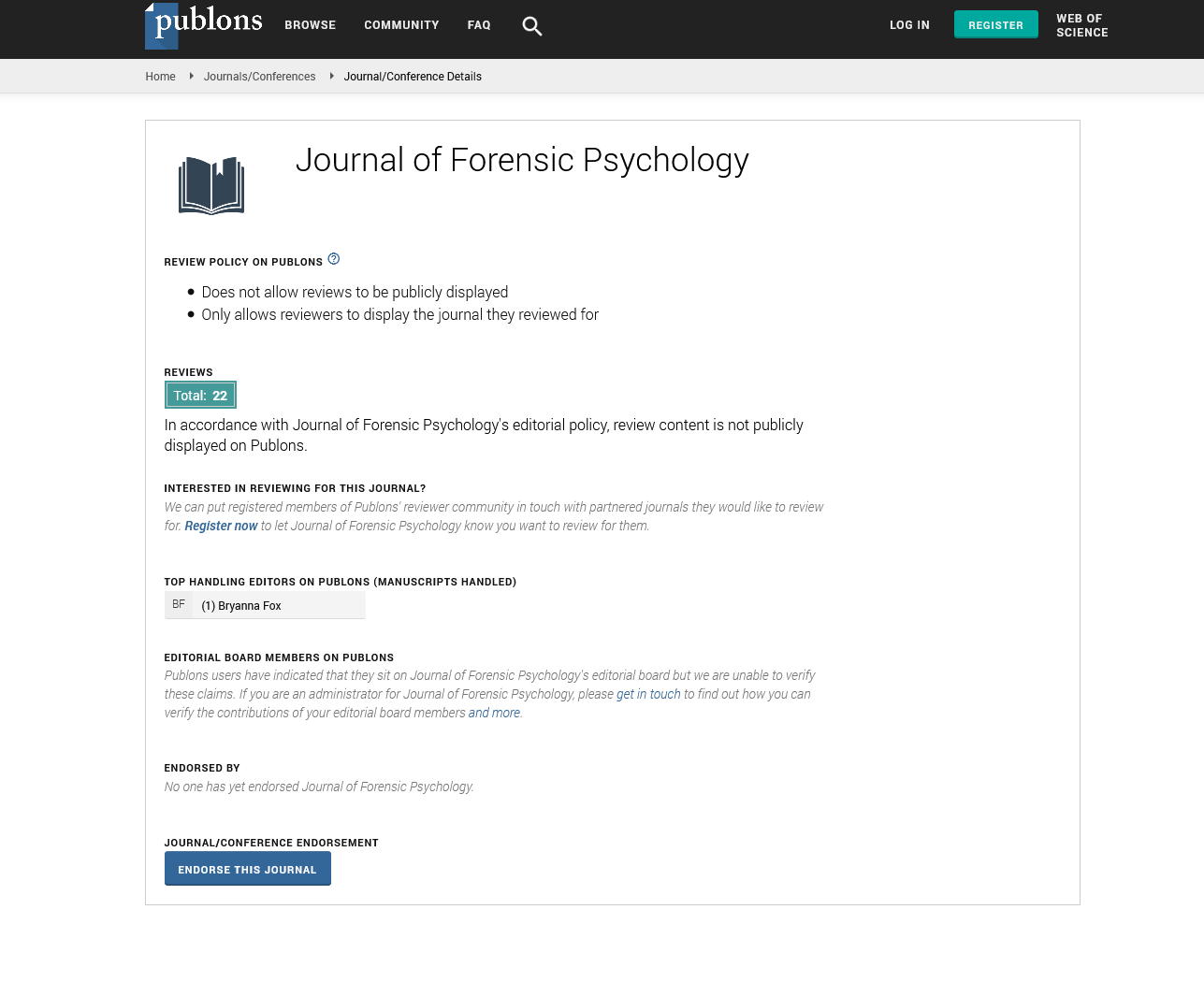Indexed In
- RefSeek
- Hamdard University
- EBSCO A-Z
- Publons
- Geneva Foundation for Medical Education and Research
- Euro Pub
- Google Scholar
Useful Links
Share This Page
Journal Flyer

Open Access Journals
- Agri and Aquaculture
- Biochemistry
- Bioinformatics & Systems Biology
- Business & Management
- Chemistry
- Clinical Sciences
- Engineering
- Food & Nutrition
- General Science
- Genetics & Molecular Biology
- Immunology & Microbiology
- Medical Sciences
- Neuroscience & Psychology
- Nursing & Health Care
- Pharmaceutical Sciences
Perspective - (2025) Volume 10, Issue 1
The Impact of Risk Assessment on Justice and Public Safety
Brittany Street*Received: 31-May-2025, Manuscript No. JFPY-25-29202; Editor assigned: 02-Jun-2025, Pre QC No. JFPY-25-29202 (PQ); Reviewed: 16-Jun-2025, QC No. JFPY-25-29202; Revised: 23-Jun-2025, Manuscript No. JFPY-25-29202 (R); Published: 30-Jun-2025, DOI: 10.35248/2475-319X.25.10.373
Description
Risk assessment is a fundamental process in forensic psychology, aimed at evaluating the likelihood that an individual may engage in future harmful behaviors, including violence, criminal activity, or self-harm. It is a multidimensional evaluation that combines clinical judgment, actuarial tools, and structured professional guidelines to inform decisions in legal, correctional, and clinical contexts. The goal is not only to predict risk but also to manage and reduce it through targeted interventions.
The foundation of risk assessment lies in understanding the interplay of individual characteristics, historical factors, situational triggers, and contextual variables. These include static risk factors, such as criminal history or early onset of antisocial behavior, and dynamic risk factors, like current substance abuse or unstable interpersonal relationships. Static factors are unchangeable but offer strong predictive validity, while dynamic factors are changeable and thus critical for risk management. The integration of both types allows forensic psychologists to provide more nuanced, case-specific evaluations.
Various models of risk assessment have evolved over time. Unstructured clinical judgment, once common, is now considered less reliable due to its subjective nature. In contrast, actuarial risk assessment tools, such as the Static-99 for sexual offenders or the Violence Risk Appraisal Guide (VRAG), offer standardized approaches based on statistical associations. These tools, though more objective, may not account adequately for individual variability or contextual nuances. To bridge this gap, Structured Professional Judgment (SPJ) models such as the HCR-20 and SAVRY have gained prominence. These methods blend empirical evidence with professional discretion, allowing for more tailored assessments while maintaining reliability.
The application of risk assessment spans diverse forensic settings. In criminal courts, it can influence decisions regarding bail, sentencing, or parole. In civil contexts, it informs rulings on involuntary commitment or child custody. Correctional institutions rely on these evaluations to determine security classification, treatment needs, and eligibility for early release. In each context, the stakes are high, as errors in judgment can lead to either unjust restrictions of liberty or failure to prevent harm.
Ethical considerations are central to the practice of forensic risk assessment. Professionals must be aware of potential biases and ensure cultural competence in interpreting behavior across diverse populations. Misapplication of risk tools or overreliance on certain predictors can lead to discriminatory outcomes, particularly against minorities or individuals with mental health issues. Transparency in methodology and clear communication of findings are essential to uphold the principles of justice and fairness.
In recent years, advances in technology and data science have introduced new avenues for enhancing risk assessments. Machine learning algorithms and big data analytics offer promising improvements in predictive accuracy. However, these innovations also raise concerns about transparency, accountability, and the potential dehumanization of the assessment process. As forensic psychology moves forward, it is crucial to balance technological advances with ethical practice and human judgment.
Training and continuing education for professionals are key to effective risk assessment. Practitioners must stay updated on evolving tools, research findings, and legal standards. Multidisciplinary collaboration between psychologists, legal professionals, correctional staff, and social workers further enhances the quality and relevance of assessments.
Conclusion
Ultimately, risk assessment is not a static or purely predictive task but a dynamic process that informs strategies for intervention and rehabilitation. By identifying risk factors and protective elements, forensic psychologists contribute to public safety, individual well-being, and the overall integrity of the justice system. Their assessments guide crucial decisions and have long-term implications for individuals and society alike, underscoring the need for rigorous, ethical, and evidence-based practice in this critical domain.
Citation: Street B (2025). The Impact of Risk Assessment on Justice and Public Safety. J Foren Psy. 10:373.
Copyright: © 2025 Street B. This is an open-access article distributed under the terms of the Creative Commons Attribution License, which permits unrestricted use, distribution, and reproduction in any medium, provided the original author and source are credited.

